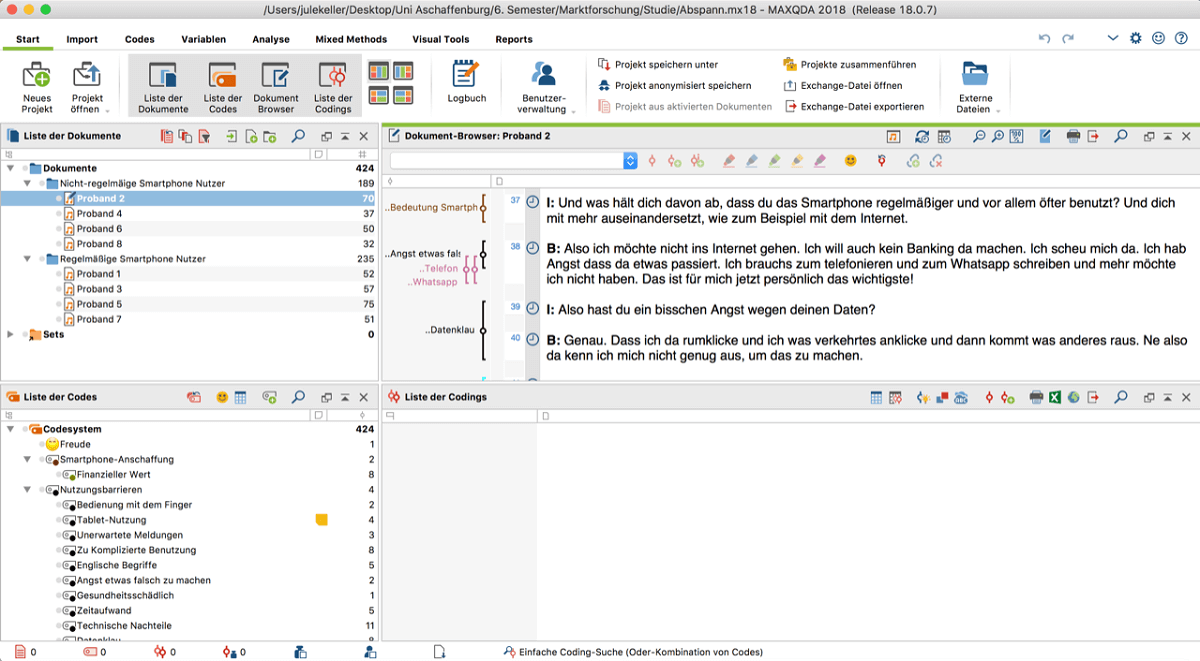Guest post by Prof. Dr. Oliver Hugo.
Using MAXQDA in the introductory module “Qualitative Market Research” at the University of Applied Sciences, Aschaffenburg
In summer 2018, we implemented MAXQDA in the introductory module Qualitative Market Research at the University of Applied Sciences in Aschaffenburg for the first time. This module is typically situated in the sixth semester of the Bachelor of Science degree program called Multimedia Communication and Documentation.
Established in 2011, the course aims to educate generalists in many areas pertaining to corporate and institutional communications. In particular, we provide an academically rigorous education for the expanding and rapidly changing fields of market communication and technical documentation.

University of Applied Sciences, Aschaffenburg
The basics of market research
Qualitative market research plays a vital role in many functions ranging from product development and marketing to communication. Among others, it furnishes brands with compelling consumer insights to craft and hone positioning statements, it can uncover new knowledge about unmet consumer needs – and thus pave the way for novel segmentations – and it can help to explore opportunities for many kinds of market development efforts. As such, it is a natural fit for a degree programme focused on communication in all its forms.
About 60 students enrolled in the course which was structured around two phases. Initially, students systematically absorbed the basics of qualitative market research, looking at issues such as developing realistic research questions, creating a research design, selecting a sample, designing a discussion guide, conducting interviews, as well as analyzing and presenting qualitative data.
Qualitative Data Analysis with MAXQDA
MAXQDA was introduced in a lecture format that highlighted the core functions, whilst learning the ropes of working with the software was a supervised, hands-on activity during which MAXQDA’s free video tutorials were frequently used.

Student’s market research project in MAXQDA 2018
(Screenshot by Jule Keller)
Practical projects
This knowledge provided the foundation for the second phase – individual student projects. As topics could be chosen freely we saw a broad range of themes including, for example, “usage of smartphones by the elderly”, “women and football”, “attitudes towards religion”, “motivations behind playing particular video games”, and “product testing for an animal health care innovation”.

Student’s coding work in MAXQDA’s “Code System” Window
(Screenshot by Lea Reuter)
Student projects culminated in a report as well as a simulated client presentation to be delivered to the instructors. They also served as the basis on which students were ultimately assessed. To develop a degree of proficiency with leading qualitative data analysis software – increasingly a sine qua non in the qualitative research community – students were given the opportunity to work with MAXQDA throughout their individual projects.
Reporting with MAXQDA’s Smart Publisher
Student experiences using MAXQDA
After about eight weeks of intensive and supervised coursework, projects were handed in and students’ presentations were delivered. Students were subsequently asked to evaluate the module and, among others, requested to report on their experience of using MAXQDA.

Student’s code visualization created using MAXQDA’s MAXMaps Feature
(Screenshot by Lea Reuter)
The results were unambiguous, with 94% of responding students feeling so positive about their experience that they would recommend continued use of the software in future module iterations. Our personal observations during supervision and assessment confirm this very positive reception of MAXQDA.
Asked to comment on their experience with the software, students typically provided answers such as these:
- “Very useful, also for future work!”
- “Great! It saved a lot of time during transcription and analyzing my interviews. Without MAXQDA, I would have needed three times as long…”
- “The basic functions of the software are very easy to learn.”
- “MAXQDA significantly contributed to structuring our project.”
- “The project was a great success thanks to MAXQDA.”
In a Nutshell
We conclude that the vast majority of students appreciated getting to know and working with MAXQDA as part of this introductory module. There were some suggestions for improvement and these largely reflected students’ desire to learn even more about the software’s advanced functionalities in the preparatory phase of the course.

We are convinced that the ability to gain first-hand experience with qualitative market research generally – and the power of leading qualitative data analysis software in particular – will be an asset for many careers in the rapidly evolving fields of market communication and technical documentation.
About the Author
Oliver Hugo is a professor at the University of Applied Sciences Aschaffenburg (TH Aschaffenburg) in Bavaria. He holds a PhD and a Master’s degree from the University of Cambridge and is a graduate of the ESB Reutlingen and Middlesex University in London. He was a scholar of the “Studienstiftung des deutschen Volkes” and the German Academic Exchange Service. Before joining the TH Aschaffenburg, he was Director of Market Analysis & Research at Nintendo of Europe and worked in the brand management function of Procter & Gamble.

 Oliver Hugo is a professor at the University of Applied Sciences Aschaffenburg (TH Aschaffenburg) in Bavaria. He holds a PhD and a Master’s degree from the University of Cambridge and is a graduate of the ESB Reutlingen and Middlesex University in London. He was a scholar of the “Studienstiftung des deutschen Volkes” and the German Academic Exchange Service. Before joining the TH Aschaffenburg, he was Director of Market Analysis & Research at Nintendo of Europe and worked in the brand management function of Procter & Gamble.
Oliver Hugo is a professor at the University of Applied Sciences Aschaffenburg (TH Aschaffenburg) in Bavaria. He holds a PhD and a Master’s degree from the University of Cambridge and is a graduate of the ESB Reutlingen and Middlesex University in London. He was a scholar of the “Studienstiftung des deutschen Volkes” and the German Academic Exchange Service. Before joining the TH Aschaffenburg, he was Director of Market Analysis & Research at Nintendo of Europe and worked in the brand management function of Procter & Gamble.


